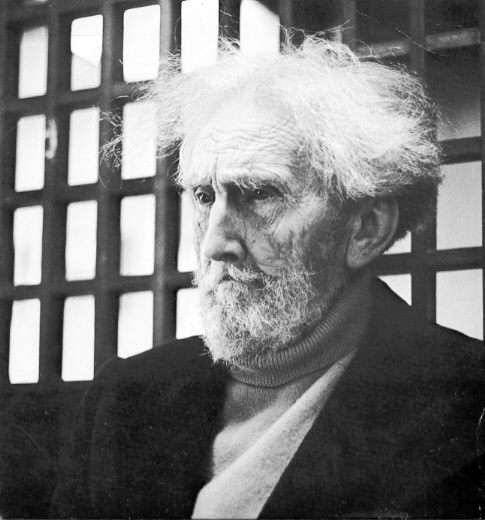 PENNsound's Pound archive is truly remarkable. This blog has already thus testified, per poet Peter Gizzi. The earliest recording that survives--The Harvard Vocarium reading in Cambridge--was made in 1939. The latest are some miscellaneous recordings made in San Ambrogio and Venice, between 1962 and 1972, by Olga Rudge. Richard Sieburth did the lion's share of the work in assembling and comprehending the Pound recordings. Even he--an expert on the topic--discovered some new things along the way. For PENNsound Richard wrote a "listener's guide" titled "The Work of Voice in the Age of Mechanical Reproduction". On May 22, 2007, I recorded a discussion with Richard about all this. You can hear it here.
PENNsound's Pound archive is truly remarkable. This blog has already thus testified, per poet Peter Gizzi. The earliest recording that survives--The Harvard Vocarium reading in Cambridge--was made in 1939. The latest are some miscellaneous recordings made in San Ambrogio and Venice, between 1962 and 1972, by Olga Rudge. Richard Sieburth did the lion's share of the work in assembling and comprehending the Pound recordings. Even he--an expert on the topic--discovered some new things along the way. For PENNsound Richard wrote a "listener's guide" titled "The Work of Voice in the Age of Mechanical Reproduction". On May 22, 2007, I recorded a discussion with Richard about all this. You can hear it here.
Tuesday, July 10, 2007
a listener's guide to Ezra Pound
 PENNsound's Pound archive is truly remarkable. This blog has already thus testified, per poet Peter Gizzi. The earliest recording that survives--The Harvard Vocarium reading in Cambridge--was made in 1939. The latest are some miscellaneous recordings made in San Ambrogio and Venice, between 1962 and 1972, by Olga Rudge. Richard Sieburth did the lion's share of the work in assembling and comprehending the Pound recordings. Even he--an expert on the topic--discovered some new things along the way. For PENNsound Richard wrote a "listener's guide" titled "The Work of Voice in the Age of Mechanical Reproduction". On May 22, 2007, I recorded a discussion with Richard about all this. You can hear it here.
PENNsound's Pound archive is truly remarkable. This blog has already thus testified, per poet Peter Gizzi. The earliest recording that survives--The Harvard Vocarium reading in Cambridge--was made in 1939. The latest are some miscellaneous recordings made in San Ambrogio and Venice, between 1962 and 1972, by Olga Rudge. Richard Sieburth did the lion's share of the work in assembling and comprehending the Pound recordings. Even he--an expert on the topic--discovered some new things along the way. For PENNsound Richard wrote a "listener's guide" titled "The Work of Voice in the Age of Mechanical Reproduction". On May 22, 2007, I recorded a discussion with Richard about all this. You can hear it here.






 "I teach horizontally, meaning that while I might begin with a fixed idea of what I'm going to teach that day, I let it drift rhizomatically way off topic, often pulling it back when it gets too far. I rely on non-fixed materials to teach this way; the whole world is at my fingertips. Should I go off on a tangent about John and Rauschenberg and their love relationship as expressed in Rauschenberg's bed, an image of that bed is always a click away. From there, we can head anywhere into the non-fixed universe, be it film, text or sound. And of course, that always takes us elsewhere. As Cage says, 'We are getting nowhere fast.'"
"I teach horizontally, meaning that while I might begin with a fixed idea of what I'm going to teach that day, I let it drift rhizomatically way off topic, often pulling it back when it gets too far. I rely on non-fixed materials to teach this way; the whole world is at my fingertips. Should I go off on a tangent about John and Rauschenberg and their love relationship as expressed in Rauschenberg's bed, an image of that bed is always a click away. From there, we can head anywhere into the non-fixed universe, be it film, text or sound. And of course, that always takes us elsewhere. As Cage says, 'We are getting nowhere fast.'" 

 that anyone has yet got the imaginative measure of that terrifying day six years ago. Certainly our Tolstoy has not crawled out of the rubble. The closest we have, Don DeLillo, succeeded as an essayist-journalist ("In the Ruins of the Future: Reflections on Terror and Loss in the Shadow of September,” Harper’s, December 2001) but, to my mind, failed as a novelist ("Falling Man"). One reason, perhaps, is that the remembered emotion was instantly buried under a pile of cultural junk.' - Tod Gitlin in his review of Susan Faludi's The Terror Dream (written for
that anyone has yet got the imaginative measure of that terrifying day six years ago. Certainly our Tolstoy has not crawled out of the rubble. The closest we have, Don DeLillo, succeeded as an essayist-journalist ("In the Ruins of the Future: Reflections on Terror and Loss in the Shadow of September,” Harper’s, December 2001) but, to my mind, failed as a novelist ("Falling Man"). One reason, perhaps, is that the remembered emotion was instantly buried under a pile of cultural junk.' - Tod Gitlin in his review of Susan Faludi's The Terror Dream (written for 






























